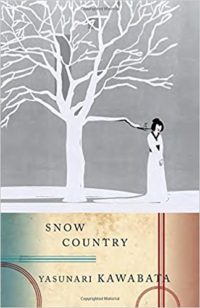The sound of the freezing of snow over the land
 Snow Country
Snow Country
by Yasunari Kawabata
translated from Japanese by Edward G Seidensticker
This is a classic novel about a man who travels from Tokyo to a small hot spring town in the mountains in December. It’s a short book filled with beautiful descriptions of people, scenery and everyday life.
Shimamura’s thoughts and intentions are revealed slowly. The novel opens with him on the train, staring at the reflection in the window of an attractive woman sat near him. Kawabata goes into great detail of the way the reflected image changes in response to the changing light and scenery outside. It’s a mark of the story to follow, this attention to the specifics of small moments.
“It was a stern night landscape. The sound of the freezing of snow over the land seemed to roar deep into the earth. There was no moon. The stars, almost too many of them to be true, came forward so brightly that it was as if they were falling with the swiftness of the void. As the stars came nearer, the sky retreated deeper and deeper into the night colour. The layers of the Border Range, indistinguishable one from another, cast their heaviness at the skirt of the starry sky in a blackness grave and sombre enough to communicate their mass.”
On arrival at the mountain village, he spots a geisha in the inn – a woman he had been hoping to see again. It turns out that Shimamura has been here before, in May, when he got to know the woman, before she was a geisha and just helped out at parties. Her geisha name is Komako – we never learn her old name.
The story is a meditation on life in the mountains in winter. It’s also the story of a new geisha who has had an incomplete education and is only now realising that her love affairs must, of necessity, be brief. Shimamura is practical about his relationship with her – he is a married man who prefers a certain geisha and at some point he will go home and leave her. But Komako is passionate, impetuous, jealous – perhaps not ideally suited to the life she has to live.
“A chill swept over Shimamura. The goose flesh seemed to rise even to his cheeks. The first notes opened a transparent emptiness deep in his entrails, and in the emptiness the sound of the samisen reverberated. He was startled – or, better, he fell back as under a well-aimed blow. Taken with a feeling of reverence, washed by waves of remorse, defenceless, quite deprived of strength – there was nothing for him to do but give himself up to the current, to the pleasure of being swept off wherever Komako would take him.”
This novel was among three cited when Kawabata won the Nobel Prize for Literature in 1968. It is rather beautiful and while on the surface it might seem to romanticise the life of a geisha, reading between the lines, the reality is there.
While we are in Japan, we won’t be travelling to this specific hot spring town (though it isn’t named in the story, the setting is widely understood to be Yuzawa in Niigata prefecture) but we are planning a trip to the mountains north of Tokyo, and I like to think some of Kawabata’s descriptions will ring true for me. Sadly, light pollution maps suggest we won’t get to see the Milky Way as Shimamura does (some things have changed since 1937) and our train journey will be a tad faster (Shinkansen!!) but the snow and the mountains will remain.
Yukiguni published 1937.
This translation first published 1956 by Alfred A Knopf.
Source: Amazon.